È frustrante cercare di visitare una pagina web e ritrovarsi con l’errore “Pagina non trovata”. Questo può danneggiare il vostro brand e i visitatori potrebbero semplicemente spostarsi su un altro sito web.
Noi di WPBeginner siamo consapevoli che i link rotti possono danneggiare l’esperienza dell’utente e la SEO. Per questo utilizziamo All-in-uno SEO per reindirizzare gli utenti ai contenuti che stanno cercando.
Quando qualcuno visita il vostro sito utilizzando un vecchio link a una pagina che è stata spostata, un reindirizzamento 301 lo porterà automaticamente alla nuova pagina, in modo che non veda un errore 404: la pagina non è stata trovata.
In questo articolo vi mostreremo come creare reindirizzamenti 301 in WordPress utilizzando All in One SEO e altri strumenti, in modo da offrire una migliore esperienza utente e migliorare il posizionamento delle parole chiave.

Che cos’è una reindirizzazione in WordPress?
Un reindirizzamento è un modo per il vostro sito WordPress di inviare automaticamente gli utenti a un nuovo indirizzo quando la pagina che desiderano visitare è stata spostata o sostituita. È simile al modo in cui l’ufficio postale reindirizza la posta quando si cambia casa.
Esistono vari tipi di reindirizzamento, identificati da numeri come 301, 302 e 307. Questi reindirizzamenti indirizzano automaticamente il browser web dell’utente a un URL diverso quando si cerca di visitare una pagina che non esiste.
In questa guida per principianti, ci concentreremo sui reindirizzamenti 301, poiché sono quelli che importano di più. Essi indicano al browser che la pagina è stata spostata in modo permanente nella nuova posizione e che non si intende spostarla di nuovo.
Detto questo, vediamo quando è opportuno utilizzare un reindirizzamento 301.
Quando è necessario un reindirizzamento 301 in WordPress?
Il motivo principale per utilizzare un reindirizzamento 301 è quando il sito o una pagina del sito è stata spostata e si desidera indirizzare l’utente a una nuova pagina.
È necessario anche quando si intende modificare il permalink di un post o di una pagina.
Se non si imposta il reindirizzamento, gli utenti vedranno un errore 404 quando la pagina non viene trovata. Questo crea un’esperienza negativa per l’utente e può avere un impatto sulla SEO di WordPress.
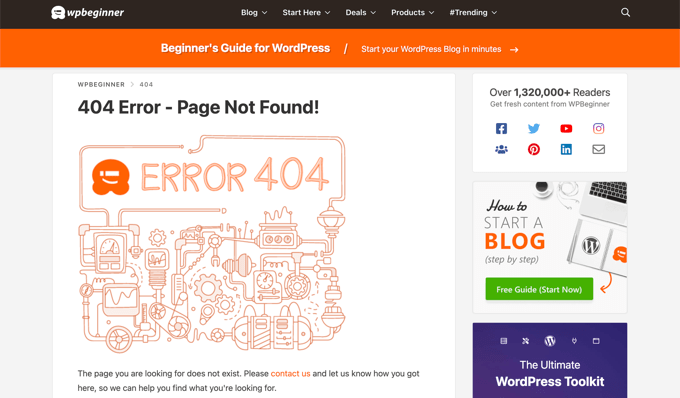
Se il vostro sito contiene molti link non funzionanti, potete anche perdere backlink preziosi. Ciò si tradurrà in un calo significativo dell’autorità del dominio e del posizionamento delle parole chiave.
Ecco perché i reindirizzamenti 301 sono molto importanti. Consentono di comunicare ai motori di ricerca e agli utenti che la pagina che stanno cercando di raggiungere è stata spostata in modo permanente in una nuova posizione.
In questo modo, tutto il traffico e i backlink della vecchia pagina vengono trasferiti alla nuova.
Vediamo ora come creare reindirizzamenti 301 in WordPress. Vi mostreremo come farlo facilmente con diversi plugin di reindirizzamento per WordPress e manualmente utilizzando il codice.
Video tutorial
Se preferite le istruzioni scritte, continuate a leggere.
Metodo 1: Creare reindirizzamenti 301 con il plugin AIOSEO
Il modo più semplice per gestire e creare reindirizzamenti 301 è il plugin All in One SEO (AIOSEO) per WordPress. È il miglior plugin SEO per WordPress ed è utilizzato da oltre 3 milioni di professionisti per migliorare la SEO dei loro siti.
AIOSEO offre un potente addon per la gestione dei reindirizzamenti che rende molto facile trovare i link non funzionanti sul vostro sito web e impostare i reindirizzamenti 301 per risolverli.
Nota: per utilizzare il gestore di reindirizzamenti è necessario AIOSEO Pro. Esiste anche una versione gratuita di AIOSEO, ma non include i reindirizzamenti 301.
Innanzitutto, è necessario installare e configurare il plugin AIOSEO Pro sul proprio sito web. Per maggiori informazioni, consultate la nostra guida passo-passo su come configurare correttamente All in One SEO.
Una volta che il plugin è attivo, dovrete andare su All in One SEO ” Reindirizzamenti nella vostra dashboard di WordPress e poi fare clic sul pulsante “Attiva reindirizzamenti”.
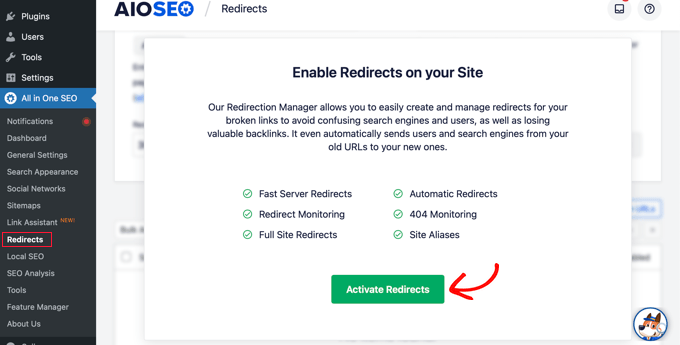
Successivamente, si può fare clic sulla scheda “Impostazioni” e selezionare “PHP” come metodo di reindirizzamento.
Questo è il metodo più semplice per creare redirect e non richiede alcuna configurazione lato server.
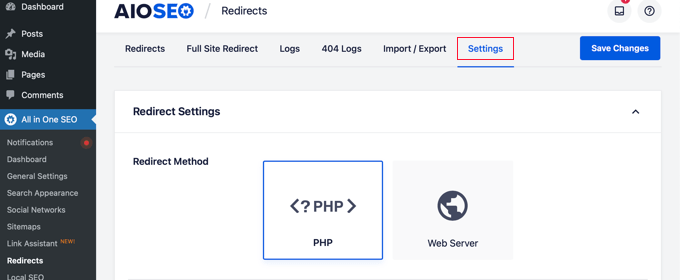
AIOSEO consente anche di selezionare il metodo di reindirizzamento del server web. Tuttavia, è necessaria la configurazione di Apache o NGINX sul server web. È necessaria una conoscenza tecnica e non è consigliata ai principianti.
Creare reindirizzamenti 301
Ora si è pronti a creare i reindirizzamenti 301. Per iniziare, andare alla scheda “Reindirizzamento”.
Per prima cosa, è necessario inserire il link che si desidera reindirizzare nel campo “URL di origine”. Dopodiché, si deve inserire la nuova destinazione del link nel campo “URL di destinazione”.
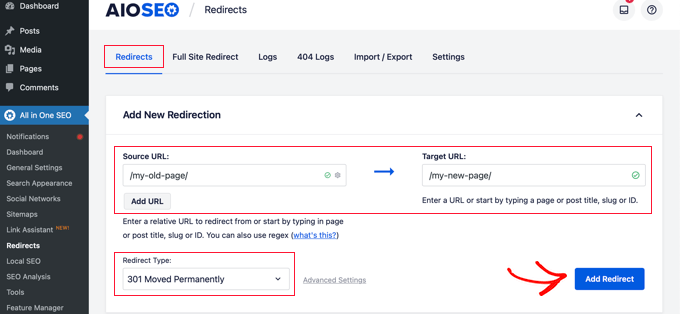
Assicurarsi che il tipo di reindirizzamento sia “301 Moved Permanently” e fare clic sul pulsante “Add Redirect”.
Se si desidera reindirizzare più URL a una nuova posizione, è sufficiente fare clic sul pulsante “Aggiungi URL” sotto il campo URL di origine.
Successivamente, è possibile scorrere verso il basso per visualizzare i log dei reindirizzamenti creati. La colonna “Hits” mostra il numero di persone che hanno visitato il link reindirizzato, mentre l’opzione “toggle” consente di attivare o disattivare i singoli reindirizzamenti 301.

Aggiunta di reindirizzamenti 301 per risolvere gli errori 404
AIOSEO può anche aiutarvi a monitorare le pagine di errore 404 e a risolverle.
Per attivare questa opzione, è necessario scorrere fino alla sezione “Registri di reindirizzamento” nella scheda Impostazioni. Quindi attivare le opzioni “Registri 404” e “Registri di reindirizzamento”.
È inoltre possibile selezionare il periodo di tempo in cui conservare i registri. Si consiglia di conservarli per un massimo di un mese per ottenere prestazioni del server fluide e veloci.
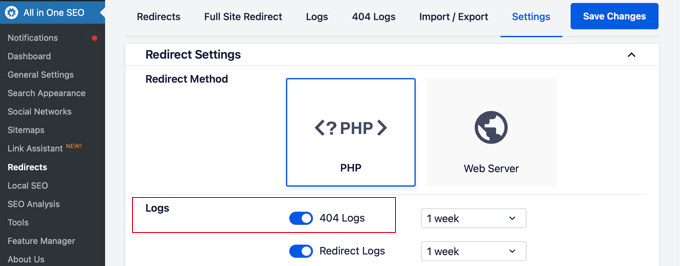
Dopo aver abilitato queste opzioni, assicurarsi di fare clic sul pulsante “Salva modifiche”.
A questo punto dovrebbe apparire una nuova scheda “404 Logs” nella sezione Redirects. È qui che AIOSEO terrà traccia e mostrerà i vostri link interrotti e vi permetterà di impostare i reindirizzamenti. Sotto la voce “Hits” si vedrà anche il numero di visite al link e la data e l’ora dell’ultimo accesso.
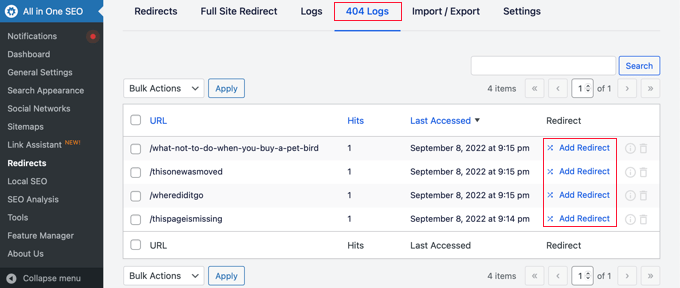
Nota: quando si abilita il log 404 per la prima volta, non si troverà alcun dato. Il plugin inizia a registrare le pagine di errore 404 solo dopo aver attivato l’impostazione.
Quindi, fare clic sul link “Aggiungi reindirizzamento” accanto all’URL dell’errore 404 che si desidera reindirizzare. Non si tratta del pulsante in basso.
A questo punto si vedranno le opzioni per inserire un URL di destinazione e selezionare il tipo di reindirizzamento dal menu a discesa.

Inserire il nuovo URL e scegliere ‘301 Moved Permanently’ come tipo di reindirizzamento. Ora si deve fare clic sul pulsante “Aggiungi reindirizzamento”.
AIOSEO creerà ora un reindirizzamento 301 per il vostro link non funzionante. Per verificare se il reindirizzamento funziona correttamente, basta visitare il vecchio URL per controllare se si viene portati alla nuova destinazione.
Aggiunta di reindirizzamenti 301 direttamente da un post o da una pagina
AIOSEO consente anche di reindirizzare un post o una pagina pubblicata mentre la si sta modificando.
Se si scorre la pagina in fondo all’editor di WordPress, si troverà una sezione “Impostazioni AIOSEO”. È necessario fare clic sulla scheda “Reindirizzamenti”.
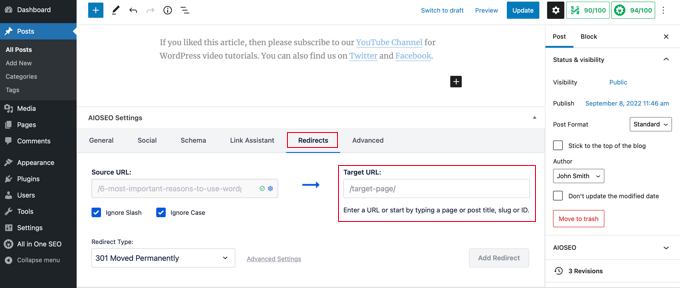
L’URL di origine è stato compilato per voi. È sufficiente inserire il nuovo URL nel campo “URL di destinazione” e selezionare “301 Moved Permanently” dal menu a discesa Tipo di reindirizzamento.
Inoltre, se si cambia il permalink di un post durante la modifica, AIOSEO si offrirà di reindirizzare il vecchio URL a quello nuovo.
In ogni caso, fare clic sul pulsante “Aggiungi reindirizzamento” e il gioco è fatto.
Reindirizzamento di siti web completi
Se spostate il vostro sito web su un nuovo nome di dominio, i vostri visitatori potrebbero trovarsi di fronte a link non funzionanti e la SEO del sito potrebbe risentirne.
Con AIOSEO è possibile spostare l’intero sito web in una nuova posizione senza perdere traffico o posizionamento nei motori di ricerca. Si tratta di un reindirizzamento 301 completo del sito.
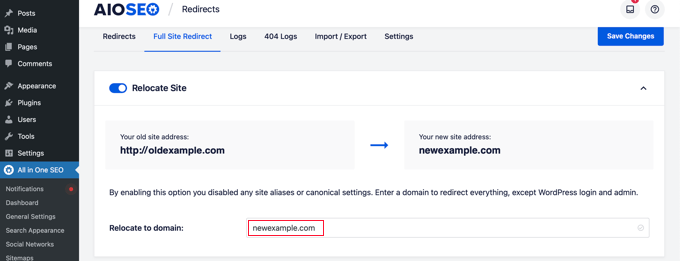
È importante farlo nel modo giusto, perciò abbiamo creato una guida per principianti che spiega passo dopo passo come effettuare un reindirizzamento completo del sito con WordPress.
Metodo 2: Creare reindirizzamenti 301 con il plugin Redirection
Un altro modo per aggiungere e gestire i reindirizzamenti in WordPress è il plugin Redirection.
Per prima cosa, è necessario installare e attivare il plugin. Potete seguire la nostra guida dettagliata su come installare un plugin di WordPress.
Nota: Sebbene l’impostazione dei reindirizzamenti 301 tramite un plugin di WordPress sia facile, presenta alcuni piccoli inconvenienti in termini di prestazioni. A seconda del vostro provider di hosting WordPress, i reindirizzamenti potrebbero essere più lenti di qualche microsecondo rispetto ad altri metodi.
Se volete rendere i vostri reindirizzamenti il più veloci possibile, potete farlo modificando il vostro file .htaccess utilizzando il metodo 5 qui sotto.
Una volta attivato, visitare Strumenti ” Reindirizzamento e fare clic sul pulsante “Avvia impostazione”.
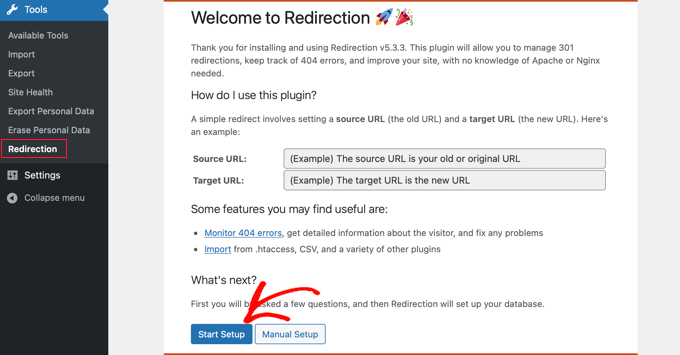
Poi, è possibile selezionare le opzioni per monitorare le modifiche dei permalink in WordPress e tenere un registro di tutti i reindirizzamenti e degli errori 404.
È sufficiente attivare queste opzioni e fare clic sul pulsante “Continua l’installazione”.
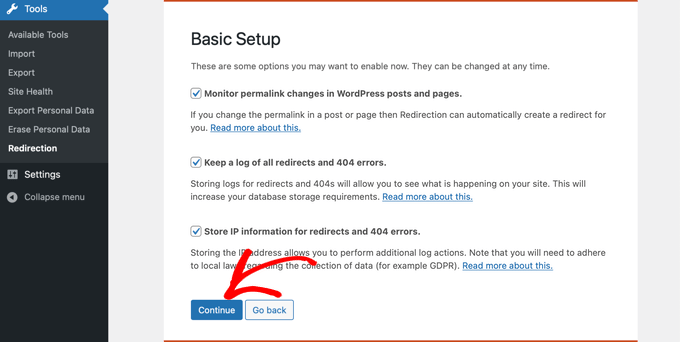
Il plugin ora testerà automaticamente l’API di riposo.
Quando lo stato risulta buono, fare clic sul pulsante “Finish Setup”.
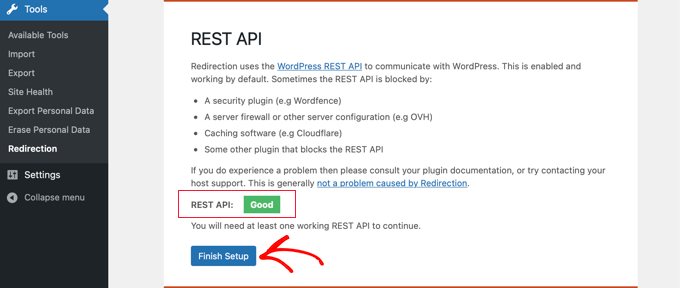
Il plugin di reindirizzamento eseguirà ancora alcune operazioni per completare la sua configurazione. Quando la barra di avanzamento raggiunge il 100%, è possibile fare clic sul pulsante “Continua” e poi sul pulsante “Pronto per iniziare”.
Il plugin è ora pronto per la creazione dei reindirizzamenti 301. Per iniziare, visitate la sezione Strumenti ” Reindirizzamento del vostro pannello WordPress. La sezione “Aggiungi un nuovo reindirizzamento” si trova nella parte inferiore dello schermo.
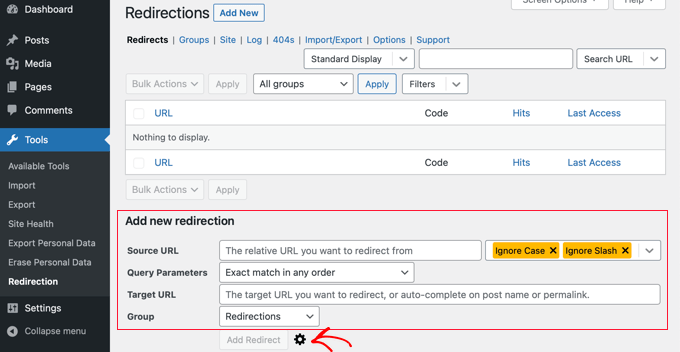
Verranno visualizzate le impostazioni di base per aggiungere un reindirizzamento. Tuttavia, se si fa clic sull’icona dell’ingranaggio, si vedranno altre opzioni per scegliere il tipo di reindirizzamento.
È sufficiente inserire l’URL di origine della vecchia pagina e aggiungere l’URL di destinazione a cui si desidera effettuare il reindirizzamento. Assicurarsi inoltre che l’opzione del codice HTTP sia impostata su “301 – Spostato in modo permanente”.

Una volta inseriti tutti i dettagli, fare clic sul pulsante “Aggiungi reindirizzamento”.
Metodo 3: Creare reindirizzamenti 301 con il plugin Simple 301 Redirects
Uno dei modi più semplici per creare reindirizzamenti 301 è il plugin Simple 301 Redirects. Come suggerisce il nome, rende i reindirizzamenti 301 molto semplici.
Per iniziare, dovrete installare e attivare il plugin sul vostro sito web.
Successivamente, è necessario visitare Impostazioni ” 301 Reindirizzamenti. Qui è possibile inserire il vecchio URL nel campo “Richiesta” e l’URL di destinazione nel campo “Destinazione”.

Una volta fatto ciò, fare clic sul pulsante “Aggiungi nuovo” per creare il reindirizzamento 301. Ecco fatto.
I reindirizzamenti 301 semplici inizieranno a funzionare immediatamente.
Metodo 4: Reindirizzamento delle pagine esistenti con link di pagina al plugin
A volte si desidera mantenere un post nel feed del sito o una pagina elencata in un certo modo sul sito, ma il contenuto è ospitato altrove. È qui che il plugin Page Links To si rivela utile.
Una volta installato e attivato, il plugin aggiunge una meta casella all’editor di WordPress. Qui è possibile inserire l’indirizzo della nuova sede in cui si desidera inviare gli utenti.
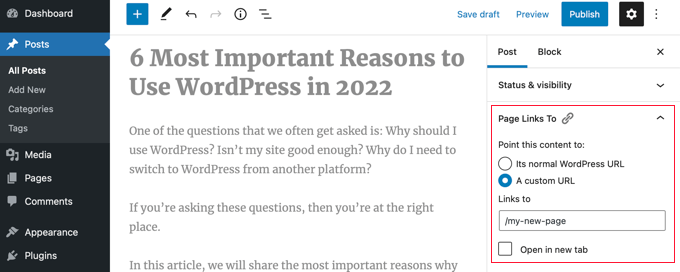
Quando si preme “Aggiorna” o “Pubblica”, WordPress tratterà il post o la pagina come di consueto, ma quando qualcuno la visiterà, verrà reindirizzato all’URL personalizzato scelto.
Ad esempio, potreste avere un blog in cui occasionalmente create contenuti scaricabili, ma volete che gli utenti del vostro negozio online vedano alcuni post come prodotti. Potete usare questo plugin per farlo senza rischiare penalizzazioni per contenuti duplicati da parte di Google o dividere la vostra base di utenti.
Metodo 5: Creare reindirizzamenti 301 manualmente con .htaccess
Gli utenti di WordPress possono anche impostare i reindirizzamenti 301 modificando il file di configurazione del server web .htaccess.
Tenete presente che un piccolo errore nel codice .htaccess può rendere inaccessibile il vostro sito WordPress, che potrebbe iniziare a mostrare l’Internal Server Error.
Per questo motivo è importante eseguire un backup del file .htaccess prima di apportare qualsiasi modifica.
Modificare il file .htaccess con il plugin All in One SEO
Se avete installato il plugin All in One SEO, questo offre un modo semplice per modificare il file .htaccess.
Nota: per utilizzare l’editor .htaccess è necessario All in One SEO Pro.
È sufficiente visitare la pagina All in One SEO ” Strumenti e passare alla scheda ‘.htaccess Editor’.
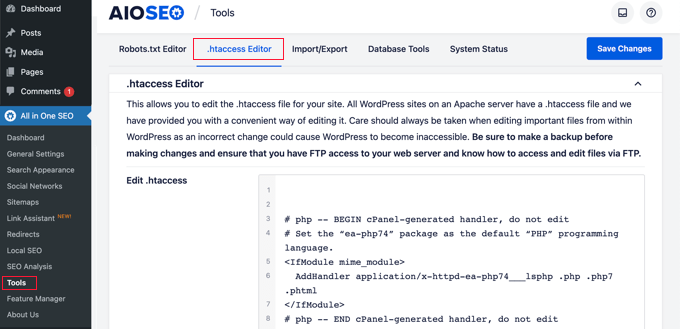
Da qui, si vedrà il contenuto del file .htaccess nell’editor. Potete semplicemente inserire il codice di reindirizzamento che volete aggiungere in fondo, dopo la riga “# END WordPress”.
Ecco un semplice reindirizzamento in cui si cerca di inviare un utente che visita un vecchio post a un nuovo post.
RewriteEngine OnRedirect 301 /a-very-old-post/ http://yoursite.com/a-very-new-post/ |
Non dimenticate di modificare gli URL del vecchio post e del nuovo post. Al termine, fate clic sul pulsante “Salva modifiche” per memorizzare le impostazioni e All in One SEO aggiornerà il file .htaccess.
Modificare direttamente il file .htaccess di WordPress
È anche possibile modificare direttamente il file .htaccess di WordPress per impostare eventuali reindirizzamenti.
Per modificare il file .htaccess, è necessario collegarsi al sito web utilizzando un client FTP. Il file .htaccess risiede nella directory principale del sito WordPress.
Se non riuscite a vedere il vostro file .htaccess, consultate la nostra guida sul perché non riuscite a trovare il file .htaccess sul vostro sito WordPress.
È possibile scaricare .htaccess sul computer e modificarlo con un editor di testo come Notepad.
È possibile utilizzare il codice di reindirizzamento sottostante per inviare un utente che visita un vecchio post a un nuovo post. Il codice va incollato alla fine del file .htaccess, dopo la riga “# END WordPress”.
RewriteEngine OnRedirect 301 /a-very-old-post/ http://yoursite.com/a-very-new-post/ |
Assicurarsi di modificare gli URL del vecchio post e del nuovo post. Dopodiché, è possibile salvare le modifiche e caricare il file .htaccess sul server.
Ora è possibile testare il reindirizzamento per assicurarsi che venga eseguito correttamente come previsto.
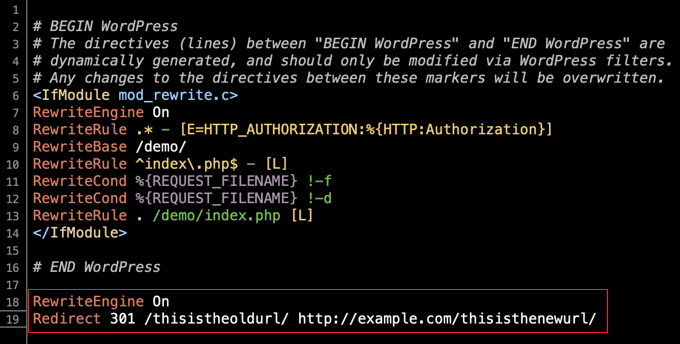
Inoltre, è possibile accedere e modificare il file .htaccess attraverso la dashboard del provider di hosting e il file manager integrato.
Ad esempio, è possibile trovare il proprio .htaccess nel file manager di SiteGround andando su Strumenti sito “ Sito “ File Manager e navigando nella cartella /public_html/ del proprio sito.
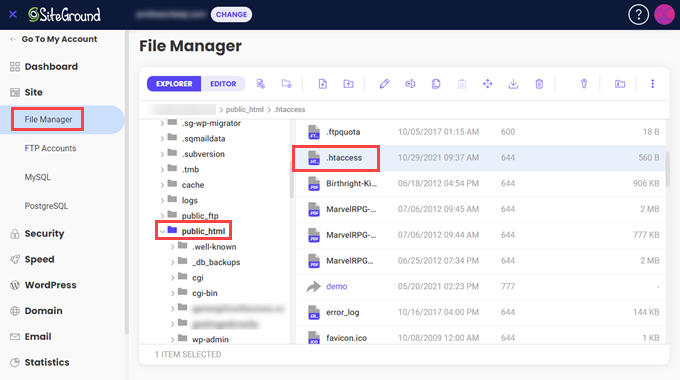
Quindi, è possibile fare clic con il tasto destro del mouse sul file .htaccess e selezionare “Modifica”.
Basta aggiungere direttamente il codice di reindirizzamento 301 e salvare il file. Anche in questo caso, assicuratevi di scaricare il file .htaccess originale per sicurezza.
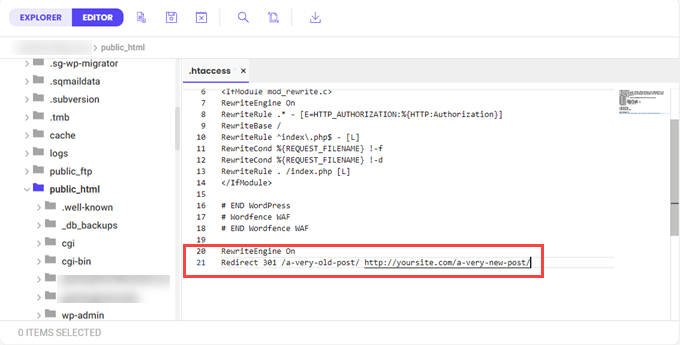
Speriamo che questa guida per principianti alla creazione di reindirizzamenti su WordPress vi abbia aiutato nell’impostazione dei reindirizzamenti sul vostro sito. Potreste anche voler consultare la nostra guida su come reindirizzare una pagina o un URL in WordPress o vedere le nostre scelte degli esperti sui migliori plugin di reindirizzamento per WordPress.
Se questo articolo vi è piaciuto, iscrivetevi al nostro canale YouTube per le esercitazioni video su WordPress. Potete trovarci anche su Twitter e Facebook.





Nick Grainger
Hi, thanks for the helpful article above.
I have switched the permalink format from plain to post, and used the AISEO Pro Redirect function to redirect to the new page URLs. That all seems to be working fine – but now I can’t edit the pages. The system seems to be looking for the original plain format page address to edit. Help!
Thanks in advance for your advice. Nick
WPBeginner Support
The WordPress editor uses the Post ID so changing the permalinks should not affect the editor. Please be sure to clear any caching and if you’re on a localhost installation, ensure you have mod_rewrite enabled in the tool you are using.
Admin
Sheryl
what should I do with the original page after redirecting? Is it better to delete or unpublished?
WPBeginner Comments
As long as proper redirects are in place, you could choose to delete the page if you are certain you no longer need it.
However, sometimes it can be a good idea to turn it into a draft in case you need to reference it later.
Lori Michelle
So I am just trying to understand. We have a wordpress website oldname.com. We rebranded the company and would love to use newname.com, but don’t want to lose any hyperlinks floating out in the world. Can I use the 301 redirect for the whole website on this website? Am I making sense? Help!!!
WPBeginner Support
To change your site’s domain we would recommend taking a look at our article below!
https://www.wpbeginner.com/wp-tutorials/how-to-properly-move-wordpress-to-a-new-domain-without-losing-seo/
Admin
Lori
So I do need to set it up somewhere else, I can’t just change the website URL name and 301 it that way, is that correct?
WPBeginner Support
If you are setting it up on the same hosting provider then you would be able to go to the 301 redirect step as long as you set up the site on the new domain.
Sean
What if you want to redirect a few specific blog posts to a new domain? For example: example.com/blog/hello-world to newsite.com/blog/hello-word. BUT, you don’t need to redirect ALL the old blog content. Just a few specific URLs?
WPBeginner Support
If you wanted it to go to a completely new URL, you would want to place the full URL in the target URL field.
Admin
Donald McKenzie
If I remove comments from my blog, do I need a redirect for the material that was removed. Not the post, just the comments.
WPBeginner Support
No, you shouldn’t need to create redirects for comments that were removed.
Admin
Donald McKenzie
Thank you very much for getting back to me.
WPBeginner Support
Glad we could be helpful
Kanka
Hi, I have a post that I want to delete however after deleting it I plan on redirecting it to a page. Is this okay?
WPBeginner Support
Yes, you can do that, as long as you have the correct URL for your redirect it should be fine
Admin
Kanka
What about the opposite situation which is redirecting a deleted page to a post?
WPBeginner Support
Yes, it works in both directions as long as you redirect the correct URLs.
Anka
I actually don’t have any problems while doing redirects, however, I have more than 50 redirects and plan to do more. Does this cause a problem as I also need to delete categories and some posts?
Rhea
Is there a way I can schedule a redirect?
James
Is there a way to bulk upload redirects via a csv file? It would be handy
WPBeginner Support
The plugin has an option to import via CSV
Admin
hamada
i have made redirection with plugin “Redirection”then i deleted the redirection item from Redirection’s setting ,but i want to get it back the same what should i do
WPBeginner Support
The simplest method would be to recreate the redirect rather than attempting to restore it.
Admin
Esmaeil
I have transfer my site from a domain to a brand new domain. how can I do the 301 redirect without entering address by address?
I mean I want to define something like this : all URLs of example.com goes to example.net for example.
thank you so much in advance.
WPBeginner Support
You would want to take a look at the redirect in our article below:
https://www.wpbeginner.com/wp-tutorials/how-to-properly-move-wordpress-to-a-new-domain-without-losing-seo/
Admin
Tim
I have the redirects set up and working great, but I have a question about finding and replacing all these redirected urls.
Is there a way to find/replace them across your complete WordPress site? Not just within the WordPress database, but also within personal HTML code, and urls within tables using TablePress added to the website.
I’m looking for a global find/replace solution, is there one?
WPBeginner Support
You could either use an analytics tool to find where the link is on your site or you could take a look at a plugin from our previous article below:
https://www.wpbeginner.com/plugins/search-and-replace-plugin-for-wordpress-database/
Admin
Diana
Is there any chance I can implement 301 in free WordPress.com? It says I’m not allowed to install plugins. Only if I’m on business plan. And I want to migrate to WordPress.org
WPBeginner Support
For moving your site from WordPress.com to org you would want to go through our guide below: https://www.wpbeginner.com/wp-tutorials/how-to-properly-move-your-blog-from-wordpress-com-to-wordpress-org/
Admin
Farukh Hussain
Hi,
I have done a redirect some time ago using ‘Redirection’ plugin.
But now I cant find that url in the plugin. Even there is no code for that url in htaccess file too.
I want to disable that redirect now. Is there any way to do this? Pls help?
WPBeginner Support
If the redirect is not in the plugin, you would want to check your htaccess file or reach out to your hosting provider for their assistance with finding the redirect.
Admin
Ginger
If I’m redirecting several web pages (not posts), do I make duplicates of the code you showed above (both lines 1 and 2) for each of the new page I am redirecting? And do I keep copying those codes at the bottom of the .htaccess file?
I read another article that suggests adding redirection codes in the functions.php file in the theme folder. The code is long and seems complicated. But I wonder, which option is more efficient — editing the .htaccess or editing the functions.php?
WPBeginner Support
You would add a new version of the second line of code, you only need the first line once. For where the redirect happens it is personal preference on which method is best.
Admin
Lindsey
Hi
Apparently my site has a 301 redirect on it, but I cannot discover where this is, nor what it is redirecting. There is nothing in the htaccess file. The site was originally built using a different name on localhost, and all the urls were changed to become the new domain name. Could this be the problem? How do I track down where the 301 is because it is causing problems with the SSL certificate. Thanks
WPBeginner Support
Updating the urls shouldn’t be an issue if they were updated correctly. If you reach out to your hosting provider they should be able to help you find what is causing the redirect.
Admin
Jessica
I can’t thank you enough for this simple guide as I’ve always been told to not touch redirects unless you know what you’re doing, so my seo suffered a bit because I ended up not doing anything. Fact is, I know enough and can follow instructions if they’re not written for developers and I don’t have to rely on a plugin that may cause problems later ’cause they all do at some point, right? Thank you. This link is going in my toolbox to share with others having the same problem.
WPBeginner Support
You’re welcome, glad our guide could be helpful for you and anyone you share it with
Admin
Wendy
I used the method in the video, but my site still has Uncategorized listed at the top and the side. I tried to find the third part of the video about changing the 301 redirect links in my settings, but it is not there. However, when I click on Uncategorized it changes to general, but when I visit my site again or refresh it is back to Uncategorized. The plugin for redirects said it was compatible with my theme. Any help is appreciated, thank you.
WPBeginner Support
It sounds like you’re trying to remove the uncategorized category from your site. If that’s the case you would want to take a look at our article here: https://www.wpbeginner.com/beginners-guide/rename-the-uncategorized-category/
Admin
Hannah
Hey there! thank you for the helpful info! I am wondering does this plugin work for a change of domain on my blog? I recently changed my domain and read that it is very important to implement a 301 redirect in order to not lose rankings and exposure. Would this do the trick? If so, would I put my old domain in the source line and the new domain in the target line?
Thank you!
WPBeginner Support
You would want to take a look at steps 4 and 5 in our article here: https://www.wpbeginner.com/wp-tutorials/how-to-properly-move-wordpress-to-a-new-domain-without-losing-seo/
Admin
Matt
Can I use “page links to” and “redirection” one the same site?
They seem like they serve different needs, but I have seen warnings that you shouldn’t use more than one redirection plugin at a time. True?
I like redirection features, but I like having something on the “edit post” view that I can use to set up a redirect (e.g., teaser/excerpt linking out to a landing page or to another site). Thanks!
WPBeginner Support
We would not recommend using the two plugins at the same time to prevent any conflicts between the two, you could check with the plugin authors for if there is a recommended method for the two plugins to work together.
Admin
Bill
I migrated a WP website to a new domain and set up a redirect from the old domain to the new one within cPanel. The redirects are nearly instantaneous (that’s good, right?) but I’d like to delay them for a few seconds, long enough to display a screen on the old homepage explaining why they’re being redirected.
I’m not a programmer. Is there a plugin that will allow me to adjust the time before the redirect occurs? TIA
WPBeginner Support
Unless I hear otherwise, we do not have a simple method we would recommend to set that up sadly.
Admin
Lee
Hello,
A great post by the way.
I have numerous pages which have been redirected to new urls, I have updated all page link urls to the new urls, so no broken links on front end.
My question is after a few months is it safe to delete any redirects which were created?
Many thanks.
Lee
WPBeginner Support
If there are no references to the broken links you could remove the redirects, otherwise it may be best to keep the redirects active.
Admin
Matthew
Hi, I have been using the redirection plugin for a while now trying to sort my old posts out from when I first started ( the permalinks were awful )
What I have been doing is creating another post with a better permalink and copy and pasting the content from the old URL to the new one and then 301 redirecting them.
After reading this post I’m starting to think that I don’t need to create a completely new post but just change the permalink on the old one and redirect it like that, Am I Correct?
If so, can I delete all the old duplicate posts from before or should I leave them as they are?
Thanks if you can help
WPBeginner Support
Correct you can modify the permalink and redirect without the need for the old post to be active. As long as the redirects are in place you can remove the old posts if you wanted.
Admin
Matthew
So just to clarify, I can delete the old posts that I copied and pasted into a new one and redirected the URL, and that all I have to do is to modify the permalink and not copy and paste the whole URL into a different post but just redirect the old permalink to the new one?
Thanks so much for replying to me, you have saved me so much time if that’s the case
WPBeginner Support
Correct, glad we could help
Damion Mower
Once I have set up the redirect, what do I do with the original post, delete it?
WPBeginner Support
While not required, most people do that if they no longer want the old post.
Admin
Focussed Events
Thank you this is just what I was looking for!
WPBeginner Support
Glad we could provide the answer you were looking for
Admin
Lekan
After setting a redirection can I trash the page?
WPBeginner Support
Yes you can
Admin
Wilbert Beltran
Hi, I recently duplicated a site. Let’s say the original site’s url is original.com and I created a subdomain http:testsite.orginal.com where the duplicate site is located. Now, the question is how do I do the redirection with this kind of setup. I want to make the site at original.com to be the main site.
Thanks
WPBeginner Support
For moving your site from a subdomain, you would want to take a look at our article here: https://www.wpbeginner.com/wp-tutorials/how-to-properly-move-wordpress-from-subdomain-to-root-domain/
Admin
Gina
Hi – thank you for this! Love you guys. I downloaded the plugin and have redirected some pages. Can you tell me if I should redirect mysite.com to miresite.com/ – how do I do that? somewhere along the line the “/” fell away. There were 4 different redirect plugins on the WP site I am working on for a client and the site crashed last week – I deactivated them all and installed this one – all is good except for the/ thing. Am I even asking a logical question?
WPBeginner Support
You shouldn’t need to worry about redirecting the site to an address with a / at the end
Admin
Gina
Hi – I have now discovered that my page mydomian.com/ is being redirected to mydomain.com – without the /
I don’t know where this happened or how except from possibly one of the plugins I downloaded?? It is a 301 and I do not know now if this has damaged anything? All the search results show the address with the /. but when the result is clicked it go to the non /. please can you help or send me to somewhere that can help of fix
WPBeginner Support
You would first want to take a look at your plugins if any of them are designed for redirects you would want to see if that is set there. If none of those are causing the redirect you would want to see if the redirect is created in your htaccess file or under Settings>General if the address was changed there.
Tom
Great, thank you, I went with the .htaccess redirect, exactly what I was looking for.
WPBeginner Support
Glad we could help
Admin
Vinca
does this work the same for 302 redirects in an htaccess file? A client has asked to 302 redirect around 800 urls from a wordpress site to a Wix site. There are moments when it all operates fine, then we get several 404’s. Not sure if it’s because there are way too many urls or if we are overlooking something?
WPBeginner Support
The htaccess method would work for 302 redirects if you changed the number to 302. 302 redirects are temporary which could be part of your problem as well as your caching.
Admin
Md firoz ahmed
I have a WordPress site. I face some problem. I am using the woo commerce plugin. Woocommerce site automatically added product category page in my permalinks as- google.com/product-category/up/this-is-my-page. I want to redirect this link like- google.com/this-is-my-page. how can i solve this? any help
WPBeginner Support
For editing WooCommerce’s permalinks, you would want to check under Settings>Permalinks to modify them. If you take a look at WooCommerce’s documentation they explain more in depth.
Admin
Daniel Akinyele
Hi, Wp beginnger, if you could help me i will be do happy, I used the Htacces code and it worked perfectly. But i want My Media Files to redirect to itself,
So is there a code to stop The d=redirection in Wp-contents Folder..pls help me my Website is Dieing
Fahad
Great Information helps me to get out of a serious issue
Michael Wright
Thanks for this! I needed the Redirect plugin. Didn’t know it was a thing
Emmanuel Ekanem
Hello, does this redirection works for a URL complete change?
For example, I’m using olddomain.com and I bought newdomain.com, and want to redirect olddomain.com to open up newdomain.com.
Any help on that??
WPBeginner Support
Hi Emmanuel,
If you do that on your old website, then you will not be able to access it as the plugin will redirect you and your users to new domain name.
Admin
Emmanuel Ekanem
Oops, so how can I achieve this?
WPBeginner Support
You can do that by adding the following code to the .htaccess file on your old site.
RewriteEngine onRewriteCond %{HTTP_HOST} ^oldomain.com [NC,OR]RewriteCond %{HTTP_HOST} ^www.olddomain.com [NC]RewriteRule ^(.*)$ http://newdomain.com/$1 [L,R=301,NC]1-click Use in WordPress
Mauwiks
How can I redirect a single homepage to another domain but the rest of the pages from my redirected domain won’t be affected?/
Lovelyn Montepop
Thank you for this guide. Helped me a lot for a client’s request.
Kavitha
I have a subdomain for affiliate store. I want to know how to redirect from my site page to subdomain page. Please help.
Maegen
Thank You so so much! I have been blogging for about 8 months and have worked so hard to build my Pinterest account. It is where almost all my traffic comes from. A month ago I changed over to https and I didn’t realize until last night that none of my pins were redirecting to the https. I just fixed it all thanks to you!
raj
thanks for the information. i have small doubt how can i redirect old post to new post without loss of comments. i mean i need previous comments
Pearl
Thank you so much. I spent so many hours looking for this and finally got the answer here.
Angelica
Just FYI – the screenshots are out of date I think. Under Add New Redirection, I just see Source/Target URL and Group.
Aaron
Hi, I am trying to find a way to redirect to a single page similar to a 404 when a user enters a non-existent subdomain. for example if they mash the keyboard or make a typo when keying in the domain. I want to get rid of the standard wordpress ‘No Results Found…The page you requested could not be found. Try refining your search, or use the navigation above to locate the post.’
Can someone point me to the solution of this problem? Or what this is called so I can try find the solution? All I’m getting is results about making my multisite a single url…
Thank you!
Abdul Rehman
I only want to redirect when a visitor to my website clicks on an external link from my website. For example, if you were to click on a product from my page it would then redirect you first to a “You are being redirected” page, then off to the affiliate’s website.
I have been spending hours trying to do this. Please help. At this point I just want to know if it is possible with any wp plugin or any other workaround and if so how to do it.
WPBeginner Support
Hi Abdul Rehman,
It is certainly possible, but we are not aware of a plugin that does it.
Admin
Udi Burg
Is there a way to redirect using htaccess and that it will be opened in a new tab?
Laura
Hi
Is it possible to make a redirect from the wix platform to wordpress?
WPBeginner Support
Hi Laura,
Please see our guide on moving Wix to WordPress.
Admin
Hafiz Mateen Afzal
Which plugin is best to create referrel links like:
Thanks
WPBeginner Support
Hi Hafiz,
Thirsty Affiliates is the best way to manage your affiliate/referral links. Please see our guide on how to cloak affiliate links in WordPress.
Admin
cipriana leme
How do I redirect from a wordpress blog (free) to a .com blog? I cannot install plugins in the free blog, so how could I do the redirect? Any advice?
Thanks in advance
Hannah
Hello! I just created a website on WordPress.org and imported all of my content from my old site, example.wordpress.com (using WordPress.com). Is there a way to redirect all of the content from that site to my new one? The redirect instructions provided by WordPress gave me an error that the domain already exists, probably because it thought I was trying to create a new domain on WordPress.com.
My website traffic before is pretty minimal, so if anyone clicks on previous blog posts on my social channels, they’d be taken to the shut down version of my old site without the redirects – not the end of the world because I don’t have the following that would generate clicks at a later date, but you never know?
Any advice anyone has would be great!
Thanks,
Hannah
Senith Nal
your lesson is very helpful. i like it.
Shakoat Hossain
Brilliant solution to reduce redirects for worpress!
For a few days, I’m looking to solve my WP redirects issues. I don’t find out better solution even read this content.
Here, I got few good points and try to reduce redirect to increase my page load speed.
Thanks!